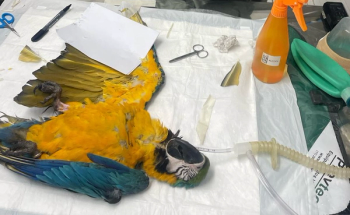
Fluid therapy for reptiles (Proceedings)
The majority of the reptile cases presented to veterinarians are dehydrated as a result of a chronic disease.
The majority of the reptile cases presented to veterinarians are dehydrated as a result of a chronic disease. Animals primarily lose moisture through the gastrointestinal and respiratory tracts, although the integument and eye (non-spectacle) are also sites where moisture is lost. Diseases associated with the gastrointestinal tract (e.g., diarrhea) or traumatic injuries to the integument (e.g., thermal burns) can increase the amount of moisture lost in our patients.
Characterizing the extent of dehydration and providing appropriate fluid replacement is necessary to successfully rehabilitate the patient. An understanding of the "water" make-up of these patients should be considered before selecting a fluid. For example, reptiles have higher total body water than mammals and the extracellular space of reptiles contains higher sodium and lower potassium levels compared to mammals (the reverse is true for the intracellular space). Therefore, fluid selection should be based on both the type of dehydration and the physiological status of the patient. Hypertonic dehydration is common in animals that have limited access to water or do not drink. Isotonic dehydration generally occurs as a result of hemorrhage, diarrhea, and short-term anorexia. Hypotonic dehydration is a common sequella to prolonged anorexia. Characterizing the state of dehydration is important to ensure that the patient is re-hydrated correctly.
Historically, isotonic balanced fluids, such as lactated ringers solution (273mOsmol/l, pH 6.6)(Abbott Laboratories, North Chicago, IL) and Normasol® (294mOsmol/l, pH 6.6)(Abbott Laboratories, North Chicago, IL), have been used when large fluid volumes are required. These fluids generally expand the extracellular space without a significant shift into the intracellular space. Prolonged usage of these fluids can lead to hypokalemia. Physiologic saline (0.9%)(308mOsm/l, pH 5.6) is preferred when there is a need for a rapid expansion of the circulatory volume, or to correct hyponatremia or alkalosis. Hypertonic solutions, such as 5% dextrose (252 mOsm/l, pH 4.3), are used when fluids are required to expand both the intracellular and extracellular spaces. The caloric input from the glucose is probably negligible and veterinarians should use appropriate enteral sources of nutrition to provide essential calories and nutrition. Combination fluids, such as 0.45% saline and 2.5% dextrose (280 mOsm/l, pH 4.3), are also commercially available.
Maintenance fluids should be provided to those animals not consuming sufficient fluids, in addition to correcting their fluid deficit. The maintenance fluid rate of reptiles is 10-30 ml/kg/day.
Fluids can be given per os (PO) in patients that are mildly dehydrated (<5%) and have a functional gastrointestinal tract. The PO route is less invasive than other techniques. Per os fluids are not recommended in cases where patients are regurgitating, vomiting or have diarrhea, as the administration of fluids by the PO route could potentiate an osmotic diarrhea. The patient must be restrained properly to ensure safe administration of fluids. Fluid administration generally requires two individuals, one to restrain the animal and one to deliver the fluids. Attempting to administer fluids PO using inappropriate techniques could lead to fluid aspiration. Fluids can be administered PO using a stainless steel gavage tube or red rubber feeding tube. The required tube length can be determined by measuring the distance between the snout and the midbody, which is the approximate location of the stomach.
Subcutaneous (SC) fluids can also be used to rehydrate mildly dehydrated patients (<5%). In severe cases of dehydration (>8%), other routes of fluid administration, such as intracoelomic, intraosseus, or intravenous fluids, should be used. There are a number of advantages to using SC fluids, including ease of administration and an ability to deliver large volumes of fluids. The primary disadvantage of using SC fluids is that the subcutaneous space in most animals is relatively avascular, leading to variable absorption rates. The most common site to administer SC fluids in snakes and lizards is the lateral body wall. In chelonians, SC fluids are generally administered in the inguinal/femoral space.
Intraosseus (IO) fluids can be used in cases with moderate to severe dehydration. The IO route may be used when peripheral vasoconstriction limits intravenous access. Intraosseous catheters are clinically advantageous and appropriate in small and fractious patients due to ease of placement, catheter stability and clinical response. The femur, tibia, and humerus may be used for IO catheter placement in reptiles. A local anesthetic, such as lidocaine, should be used to reduce the pain associated with catheter placement.
Intracoelomic (ICo) fluids can be administered to reptiles with moderate to severe dehydration. The large serosal surface area of the viscera and the coelomic membrane of reptiles serve to resorb the fluids. Irritating compounds should not be administered ICo. Intracoelomic fluids are not recommended in reptile patients that have respiratory compromise, as they may place an additional burden on the animal. Intracoelomic fluids should be given in the caudal coelomic cavity.
Intravenous fluid administration is the preferred route of fluid administration in moderately to severely dehydrated patients. The jugular vein can be used for lizards, chelonians, and snakes. Placement of the jugular catheter in the snake and lizard requires a surgical cut-down. A local anesthetic, such as lidocaine, should be used to reduce discomfort. The cephalic vein is another site for catheterization in the lizard, whereas the heart may be directly catheterized in severely moribund snakes.
To ensure success when managing reptile cases, it is important to correct any fluid deficits and provide maintenance fluids to reduce the likelihood of encountering additional deficits. If we do not correct and maintain a patient's hydration status, than additional therapeutics (e.g., antibiotics) are unlikely to work as expected.
Newsletter
From exam room tips to practice management insights, get trusted veterinary news delivered straight to your inbox—subscribe to dvm360.






